European Arrival
Laurel Hill Mansion, indeed all of Philadelphia sits on land that for millennia was inhabited by the Lanape. In the first decades of the seventeenth century European explorers and settlers in search of commercial opportunities arrived. In 1633, Dutch and Swedish investors formed the New South Company. In 1638, the Company bought a tract of land from the Lenape near present-day Wilmington, Delaware. The Company established a settlement on Tinicum Island near today’s Philadelphia International Airport. When the Dutch lose claims in North America to Great Britain, the Swedes stay and establish a community along the west bank of the Schuylkill River bearing the Lenape name, Chinssessing, "a place where there is a meadow".
Edgely Point
Around 1670 William Orian, an early settler on the Delaware River, was granted by the Court at Upland, 160 acres, known as Edgely Point, on the east bank of the Schuylkill River.
William Penn
In 1681, the King of England, Charles II handed over a large piece of
the American land holdings he claimed to William Penn, a Quaker, to pay the debts the
king owed to Penn's father.
Read more about William Penn.
![]()
Penn negotiated a land-purchase survey with the Lenape Indian tribe and purchased the first tract of land on July 15, 1682. It included the land on which Laurel Hill Mansion sits.
William Orian, having not seated his Edgely Point tract, is persuaded by William Penn to relinquish his land for First Purchaser, Dennis Rochford. William Penn granted 40 additional acres to Rochford. This 200 acre tract included the later subdivisions of Woodford, Laurel Hill, Ormiston, Rockford and Mount Pleasant.
Subdivision of Edgely Pointe
In 1694 Mary Rochford, widow of Dennis, sold the lands and buildings of Edgely Pointe, to Thomas Shute, a yeoman farmer. In 1754 Thomas Shute willed the property to his son, Joseph, on certain conditions. Joseph, unable to meet these conditions put the property up for sale. Abel James, a merchant, purchased it. Two years later Joseph purchased the property back from Abel James but was unable to hold on to it. It was at this time that the large river front property was subdivided and sold to the Philadelphia gentlemen who were to build their country houses along the banks of the Schuylkill.
The Rawle purchase and the building of Laurel Hill
In July of 1760, 76 acres of the Shute property were purchased by Joshua Howell. This parcel contained the Rochford-Shute plantation buildings and continued to be known as Edgely Farm, retaining the original name of the property. In September of that same year, Francis Rawle buys a 31 acre tract from Joshua Howell, his brother-in-law. Joshua was married to Francis’s wife Rebecca’s oldest sister, Catherine. Plans are made to build a summer villa – Laurel Hill but Francis Rawle dies a year later (1761) in hunting accident at his Frankford estate (Sweeten) on the Delaware River. This leaves Rebecca, a wealthy widow with three young children (Anna, Margaret (Peggy), William) all under the age of five.

The earliest part of Laurel Hill Mansion is pre-revolutionary built in 1767. It is a two-story Georgian brick, a popular architectural style in America before the Revolutionary War.
Rebecca Rawle supervised the building of her of summer villa, Laurel Hill Mansions, the central two story Georgian structure, in 1767 based on tax records. Rebecca was the daughter of a master builder Edward Warner, an early member of Carpenter's Company. She also remarried in 1767. Like her first husband Samuel Shoemaker, Sam, is a wealthy Quaker merchant, well-educated, liked, respected. Like his father before him, Sam Shoemaker serves two terms as Colonial Mayor of Philadelphia.
Prelude to Revolution
By the time Rebecca built her house there was already discontent in the colonies. Through the late 1760’s and early 1770’s the growing frustration leads to protest and acts of rebellion. In 1774 Philadelphia will host the First Continental Congress. A year later the city will host the Second Continental Congress. It will function as the provisional government of the United States of America through March 1, 1781. Still there are many divergent opinions in the colonies. Many Quakers believed that to keep their faith they must not pay war taxes, pay fines in lieu of military service, swear oaths of allegiance or aid military efforts while others side with the Loyalist or the Patriots.
Sam Shoemaker was the mayor of Philadelphia from 1769- 70 and served two terms in the Pennsylvania Assembly. Also, as a dry goods merchant, he supported the colonies’ grievances against England’s import-export policies. In the spring of 1775, Shoemaker petitioned Congress for permission to ship his products to Newfoundland violating the Nonimportation Agreements. This petition publicly marked Shoemaker as a loyalist sympathizer.
American Revolutionary War
1770's
Read a paper that examines the treatment of Philadelphia Quakers during Revolutionary War. ![]()
The Second Continental Congress voted to create the Continental Army on June 14, 1775.
King George III issued a proclamation on August 23, 1775 declaring elements of Britain's continental American possessions to be in a state of open rebellion.
During 1776 Congress was moving towards declaring independence from the British Empire and on July 4, 1776 the United States Declaration of Independence was approved.
Congress leaves Philadelphia in the winter of 1776–77 to avoid capture by British forces who were advancing on Philadelphia.
On September 9, 1977 a group of leading Philadelphia Quakers were banished to Virginia by the Supreme Executive Council.
Just over two weeks after the Battle of Brandywine, on September 26, 1777 British General William Howe entered and occupied Philadelphia. Howe resigns in April 1778 and the British abandon Philadelphia in June of 1778.
During the British occupation of Philadelphia, Samuel Shoemaker, served
as Magistrate of Police, and loyal to the British crown, was declared a
traitor along with many other Loyalists by the General Assembly of Pennsylvania.
Samuel was among the many Philadelphians who honestly and sincerely believed
that America's welfare and destiny belonged with a legal and constitutional
relationship with Great Britain rather than with the revolutionary alternative
which was to lead to independence. Rather than surrender, Samuel sailed
with the British fleet as they evacuated Philadelphia for New York.
His political views and actions brought considerable hardship upon the family during the Revolutionary War. As a consequence of her affiliation with Shoemaker, Rebecca lost ownership of Laurel Hill. Rebecca's
son, William then 19 years of age, accompanied his stepfather to New York
and begins studying law.
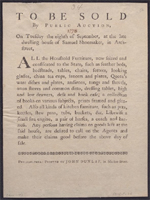 The Pennsylvania Assembly had declared Samuel Shoemaker guilty of treason on March 6, 1778, meaning his property would be forfeited to the state.
View a broadside in the collection of the Library Company of Philadelphia advertising sale of contents of Sam Shoemaker’s Arch street house by public auction.
The Pennsylvania Assembly had declared Samuel Shoemaker guilty of treason on March 6, 1778, meaning his property would be forfeited to the state.
View a broadside in the collection of the Library Company of Philadelphia advertising sale of contents of Sam Shoemaker’s Arch street house by public auction.
Rebecca and her daughters hoped that they would be allowed to keep the family properties, particularly the
house Laurel Hill that had belonged to Rebecca’s first and deceased husband, Frances Rawle. Under the law, Sam was only a “tenant by the courtesy” at
Laurel Hill , not the owner, which meant Laurel Hill should have been immune from seizure.
Historian and Rawle descendent William Brooke Rawle (1845-1915) relays the events thus: “In his patriotic zeal, Joseph Reed, acting as Supreme Executive
Council of Pennsylvania, disregarded the principle of law that the sale of such a life estate had no other effect then to free a wife’s house and land from all
of her husband’s estate when he had been attained for high treason, and to vest the title in her to as full an effect as if he had died.” Not minding the law,
Reed ordered all Shoemaker properties, including that which Rebecca had inherited from her first husband, confiscated and sold.
With the British gone the Pennsylvania government arrested 638 Philadelphians on suspicion of treason. More than one hundred people lost their property. Two of the arrested, elderly Quakers John Roberts and Abraham Carlisle were charged with collaborating with the British and hanged.
1780's
Rebecca remained in Philadelphia until 1780 when she and her son, Edward, joined Samuel in New York. In March 1780 the Supreme Executive Council intercepted one of her letter/journals and claimed she was helping loyalists pass information from Philadelphia to New York. Rebecca was then ordered to join her husband in exile. Her daughters, Anna and Peggy, remained in Philadelphia living with their maternal grandmother.
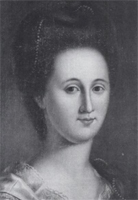 Esther DeBert Reed (1746-1780), the wife of General Joseph Reed president of the Supreme Council, lived with her children at Laurel Hill for a single summer in 1780. Joseph Reed advocated for the seizure of Loyalist properties. Very supportive of the Revolution Esther became a major fundraiser,
raising over $300,000 for the cause, running her
operation from Laurel Hill. A remarkable endeavor as she was not in the best of health. Esther and the women she organized bought cloth and thread and made shirts for the army with the funds raised.
Esther Reed died at Laurel Hill from unknown causes, possibly dysentery, at the young age of 34 years. After Reed passed, Anna Rawle wrote the
following in her journal about her tormenter: “She can never spend another summer at Laurel Hill. She is dead, and of a disorder that made some
people whisper…that she ate too many of Mr S’s (code for Shoemaker) peaches.”
Esther DeBert Reed (1746-1780), the wife of General Joseph Reed president of the Supreme Council, lived with her children at Laurel Hill for a single summer in 1780. Joseph Reed advocated for the seizure of Loyalist properties. Very supportive of the Revolution Esther became a major fundraiser,
raising over $300,000 for the cause, running her
operation from Laurel Hill. A remarkable endeavor as she was not in the best of health. Esther and the women she organized bought cloth and thread and made shirts for the army with the funds raised.
Esther Reed died at Laurel Hill from unknown causes, possibly dysentery, at the young age of 34 years. After Reed passed, Anna Rawle wrote the
following in her journal about her tormenter: “She can never spend another summer at Laurel Hill. She is dead, and of a disorder that made some
people whisper…that she ate too many of Mr S’s (code for Shoemaker) peaches.”
William Rawle sails to England in 1781 to continue his studies in law. Rebecca returned to Philadelphia in 1782, leaving Samuel and Edward in New York. Laurel Hill is advertised for sale and is purchased by Major James Parr who then leased the house to the French Ambassador, Chevalier de la Luzerne.
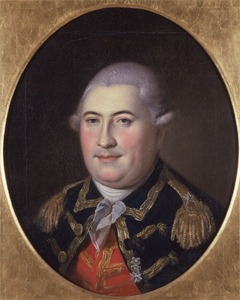
by Charles Willson Peale
Oil and Canvas
Courtesy of Independence National Historical Park
Read an excerpt of a letter to George Washington from Major General Lafayette, 12 13 June 1779 in which Chevalier de La Luzerne is introduced.

Major Parr offered Laurel Hill for sale in 1784 and Rebecca bought back
her house. She then had to negotiate with Chevalier de la Luzerne for
the remainder of his 3-year lease. She finally agreed to reimburse him
for his rent. Chevalier de La Luzerne returns to France that same year. Although Rebecca did not live at Laurel Hill she tried to
make the property pay for itself by engaging in "truck"* gardening by
growing strawberries and cabbage for sale in the Philadelphia market.
Rebecca found strawberries to be her most successful crop.
In early 1800’s, on the south side, a one story addition was added that
housed four small bedrooms.
Samual dies in 1800 and Rebecca in 1819. Her son William Rawle inherits
house. He uses it from time to time, but then leases house to Dr. Phillip
Syng Physick, who eventually buys it in 1828. Dr. Physick’s sons use the
house for Quoit Society social activities.
In 1830 Physick dies and passes house in Trust to his daughter Sally Randolph
and her husband Dr. Jacob Randolph. Laurel Hill becomes known as the Randolph
Mansion. The Octagonal addition on the north side, is Federal in style and
was added to the house sometime between 1830 and 1846 probably by Dr. Physick’s
daughter Sally Randolph. Sally’s youngest son, noted chess master Philip
Physick Randolph lives at the house for some years, but dies in 1869. Her
Trust then sells house to Fairmount Park Commission in 1869. It’s one of
the first properties to become part of the new Park system.
In 1900, the Colonial Dames of America became stewards of Randolph Mansion, making extensive repairs at their own expense to use the house for their Society Meetings. When the house was reopened in 1901, William Brooke Rawle, grandson of William Rawle, great grandson of Rebecca and her first husband Francis Rawle, was the guest speaker, and discussed the history of his ancestors and Laurel Hill Mansion, the structure they once occupied.
HIGHLIGHTS ON NOTABLE OWNERS AND SOME OF THEIR ACCOMPLISHMENTS
William Rawle, Esq. April 28, 1759 – April 12, 1836, Son of Rebecca
and Francis Rawle . Appointed as U.S. District Attorney for Pennsylvania
by George Washington in 1791. In 1796,
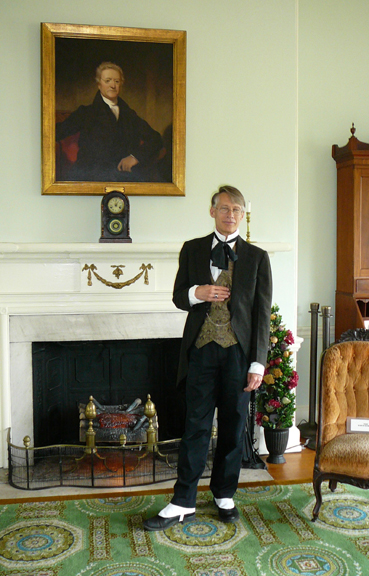 elected
Trustee of the University of Pennsylvania. Served as President of the Pennsylvania
Abolitionist Society. Served as President of the Historical Society of Pennsylvania.
Served as Attorney and Counsel for the Bank of the United States. In 1825,
William published his “View of the U.S. Constitution” the first legal treatise
on constitutional law which remained a standard reference on the subject
for over 40 years and still is used today by lawyers and government. William
Rawle found the Rawle Law Offices in 1783. In 1913, the Firm became known
as Rawle & Henderson with the addition of Joseph Henderson as a partner.
Rawle & Henderson is the oldest active law firm in the United States.
In 1827, he was elected first Chancellor of the Philadelphia Bar Association.
elected
Trustee of the University of Pennsylvania. Served as President of the Pennsylvania
Abolitionist Society. Served as President of the Historical Society of Pennsylvania.
Served as Attorney and Counsel for the Bank of the United States. In 1825,
William published his “View of the U.S. Constitution” the first legal treatise
on constitutional law which remained a standard reference on the subject
for over 40 years and still is used today by lawyers and government. William
Rawle found the Rawle Law Offices in 1783. In 1913, the Firm became known
as Rawle & Henderson with the addition of Joseph Henderson as a partner.
Rawle & Henderson is the oldest active law firm in the United States.
In 1827, he was elected first Chancellor of the Philadelphia Bar Association.
Samuel Shoemaker Served as Common Councilman of the city in 1755 and at
the death of his father he succeeded as Treasurer. Mayor of Philadelphia
from 1769-71. He was a member of the Assembly from 1771 to 1773. A successful
business man, he also was attorney for the Philadelphia Land Company of
London. During the British occupation of Philadelphia, Samuel, a Loyalist,
served as Magistrate of Police.
Dr. Philip Syng Physick, One of Philadelphia’s most noted surgeons. He was
known as the Father of American surgery for his successes in stomach surgery
and renowned clinical teaching. Dr. Physick agreed to buy Laurel Hill when
William Rawle decided to sell the family home. Sally Randolph, inherited
the house upon her father’s death. It was then known as the Randolph Mansion.
The house was renamed Laurel Hill Mansion by the City of Philadelphia during
the Bicentennial in 1976.
TENANTS LIVING AT LAUREL HILL DURING THE DURING THE REVOLUTIONARY WAR
The wife, Esther DeBert Reed, and children of General Joseph Reed, President of the Supreme Executive Council
and later, Governor of Pennsylvania. Chevalier de la Luzerne, serving as
the Ambassador from France.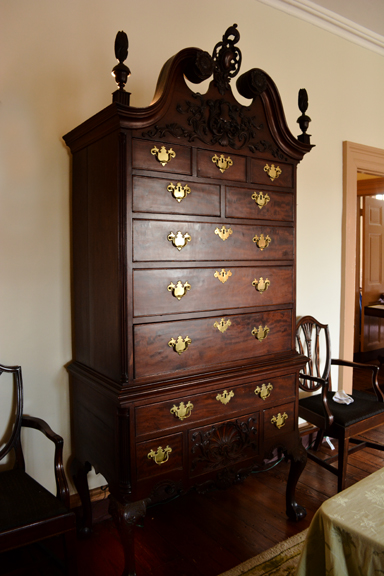
NOTABLE FURNISHING
In 1993, the Rawle family presented a valuable family heirloom to Laurel Hill, an 18th century Philadelphia chippendale mahogany highboy which has been placed in the Great Room. This original piece, was given by the Burge family upon the marriage of their daughter, Sarah, to William Rawle in 1783.
LAUREL HILL IS MAINTAINED BY WOMEN FOR GREATER PHILADELPHIA INC.
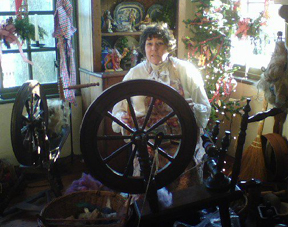 An
organization of volunteers was incorporated in 1973, under the name “Women
for the Bicentennial” as a non-profit service organization cooperating with
the City in celebrating the nation’s 200th Anniversary in 1976. First project
was the renovation and restoration of the mansion, under an agreement with
the Fairmount Park Commission At the close of 1976, the Organization changed
their name to Women for Greater Philadelphia, Inc. and has continually maintained
the mansion so it can be open for tours, concerts and education programs.
An
organization of volunteers was incorporated in 1973, under the name “Women
for the Bicentennial” as a non-profit service organization cooperating with
the City in celebrating the nation’s 200th Anniversary in 1976. First project
was the renovation and restoration of the mansion, under an agreement with
the Fairmount Park Commission At the close of 1976, the Organization changed
their name to Women for Greater Philadelphia, Inc. and has continually maintained
the mansion so it can be open for tours, concerts and education programs.
